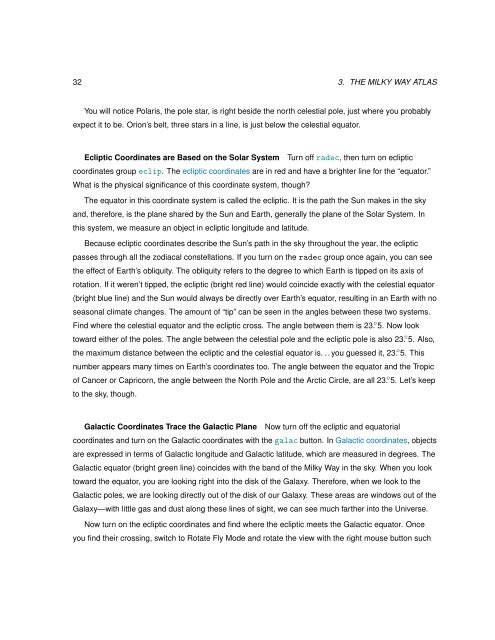Digital Universe Guide - Hayden Planetarium
Digital Universe Guide - Hayden Planetarium
Digital Universe Guide - Hayden Planetarium
Create successful ePaper yourself
Turn your PDF publications into a flip-book with our unique Google optimized e-Paper software.
32 3. THE MILKY WAY ATLAS<br />
You will notice Polaris, the pole star, is right beside the north celestial pole, just where you probably<br />
expect it to be. Orion’s belt, three stars in a line, is just below the celestial equator.<br />
Ecliptic Coordinates are Based on the Solar System Turn off radec, then turn on ecliptic<br />
coordinates group eclip. The ecliptic coordinates are in red and have a brighter line for the “equator.”<br />
What is the physical significance of this coordinate system, though?<br />
The equator in this coordinate system is called the ecliptic. It is the path the Sun makes in the sky<br />
and, therefore, is the plane shared by the Sun and Earth, generally the plane of the Solar System. In<br />
this system, we measure an object in ecliptic longitude and latitude.<br />
Because ecliptic coordinates describe the Sun’s path in the sky throughout the year, the ecliptic<br />
passes through all the zodiacal constellations. If you turn on the radec group once again, you can see<br />
the effect of Earth’s obliquity. The obliquity refers to the degree to which Earth is tipped on its axis of<br />
rotation. If it weren’t tipped, the ecliptic (bright red line) would coincide exactly with the celestial equator<br />
(bright blue line) and the Sun would always be directly over Earth’s equator, resulting in an Earth with no<br />
seasonal climate changes. The amount of “tip” can be seen in the angles between these two systems.<br />
Find where the celestial equator and the ecliptic cross. The angle between them is 23. ◦ 5. Now look<br />
toward either of the poles. The angle between the celestial pole and the ecliptic pole is also 23. ◦ 5. Also,<br />
the maximum distance between the ecliptic and the celestial equator is. . . you guessed it, 23. ◦ 5. This<br />
number appears many times on Earth’s coordinates too. The angle between the equator and the Tropic<br />
of Cancer or Capricorn, the angle between the North Pole and the Arctic Circle, are all 23. ◦ 5. Let’s keep<br />
to the sky, though.<br />
Galactic Coordinates Trace the Galactic Plane Now turn off the ecliptic and equatorial<br />
coordinates and turn on the Galactic coordinates with the galac button. In Galactic coordinates, objects<br />
are expressed in terms of Galactic longitude and Galactic latitude, which are measured in degrees. The<br />
Galactic equator (bright green line) coincides with the band of the Milky Way in the sky. When you look<br />
toward the equator, you are looking right into the disk of the Galaxy. Therefore, when we look to the<br />
Galactic poles, we are looking directly out of the disk of our Galaxy. These areas are windows out of the<br />
Galaxy—with little gas and dust along these lines of sight, we can see much farther into the <strong>Universe</strong>.<br />
Now turn on the ecliptic coordinates and find where the ecliptic meets the Galactic equator. Once<br />
you find their crossing, switch to Rotate Fly Mode and rotate the view with the right mouse button such





